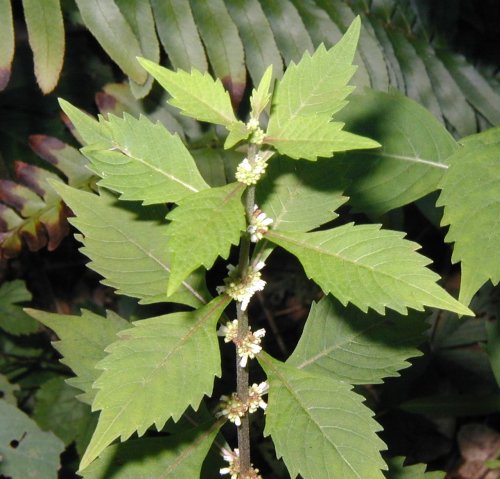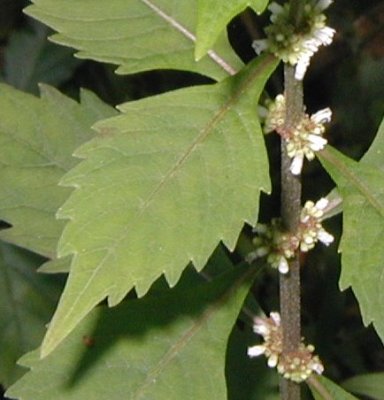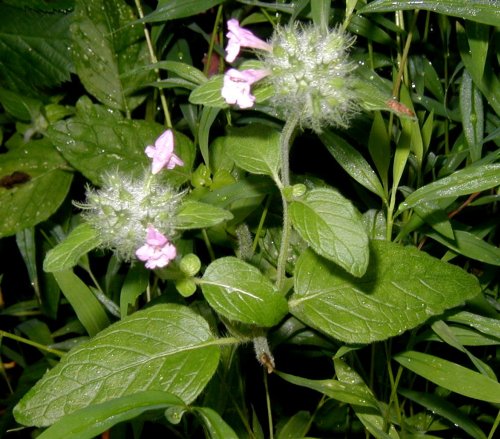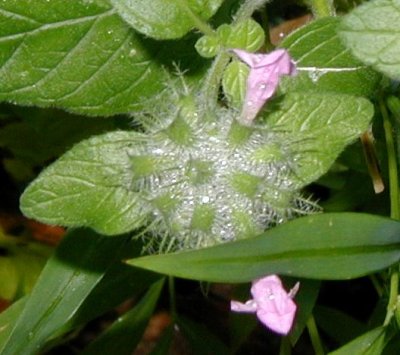Correction: American Bugleweed was incorrectly identified as Virginia Bugleweed in the original post. Changes have been made to the text below.
This wet year has brought out a few plants in abundance that are not normally seen in such numbers. So far, I’ve mentioned that the Elderberry harvest has been great, the blackberries were huge and in abundance, and the Joe-Pye Weed actually flowered this year. I think there are more of the wood asters and white snakeroot getting ready to flower this year than in the past couple of years, too. Jewelweed is flowering in great abundance now all along the lane, but especially in the lower, wetter areas.
Another new plant I’ve discovered along the lane is a non-aromatic mint. Sounds contradictory, doesn’t it? Most members of the Mint Family, Labiatae, have small glands that produce aromatic compounds that we’re familiar with, like peppermint and spearmint, but this plant is an exception. Crushing a leaf produces no smell that I can detect.
Having a squared stem, opposite leaves and tiny tubular flowers in the leaf axils are all characteristics that place American Bugleweed, Lycopus americanus, in the mint family.

American Bugleweed along the west side of the lane has toothed leaves that taper at each end and clusters of small, white axillary flowers. Photo taken 18 August 2008.

The toothed leaf of American Bugleweed is strongly tapered at both ends.
The small white axillary flowers are tubular and without a hand lens seemingly without definition. Inspecting the flowers a little closer, you can see that the top “lip” of the bugle-shaped blossom has 2 lobes while the lower lip has 3 lobes. Nearly every set of leaves occurs with clusters of flowers.
Wild mint shares a number of characteristics with its family member, American Bugleweed. Wild Mint, Mentha arvensis, sports the squared stem, opposite toothed leaves and small tubular flowers in the leaf axils. Blossoms of wild mint are typically a lilac color, but sometimes they’re white.

Wild mint grows along the east side of the upper lane, near the blackberry plants. Lower leaf sets have pairs of small leaves in the leaf axils, not flowers as the American Bugleweed does.
Other characteristics that separate Wild Mint from American Bugleweed are the stem texture and leaf shape. The bugleweed stem and leaves are smooth, while the stem of wild mint has a rougher feel due to numerous fine hairs. Wild mint leans to more of a trailing habit where its stem may curl slightly, whereas American Bugleweed grows upright and its stems are straight.
Wild mint flower clusters, and the flowers themselves, are larger than those of the bugleweed.

Wild mint flowers cluster in leaf axils. Spiny or hairy projections of the sepals are very evident after the flowers have fallen away. Photo taken 8 August 2008.
The leaves of wild mint are oval or egg-shaped and not strongly tapered at both ends like those of the bugleweed. The leaf teeth are much more prominent on bugleweed.
Wild mint, with its strong minty scent, is enjoyed as tea because of its aromatic qualities. Bugleweed doesn’t have the minty aroma, but the entire plant has been used medicinally as a mild sedative and to treat coughs, thyroid disease, heart disease and diabetes. Studies suggest further research is warranted for treating hyperthyroidism.
Since both the wild mint and bugleweed are perennials we’ll harvest some leaves and dry them for winter tea.
i just wanted to know how it tastes….i know one plant that exactly look like this but i dont know if it has been named or not yet… i will greatly appreciate if i can know how it tastes??
Hey Diva,
I haven’t tasted the bugleweed, but the mint is, well, minty! Seem right?